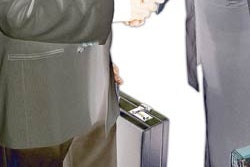
The next great advancement in the digitization of the accounts payable (A/P) process will be leveraging the vast quantities of data that it makes available. Putting these data to work for the benefit of the corporation not only results in significant financial benefits for the organization as a whole, but it also elevates the A/P function itself to the "next level" in a number of ways.
Just as 2007 saw a growing number of Fortune 1000 companies and other large organizations move to electronic invoicing, this year will see those same companies moving beyond the obvious financial gains that automating the invoice process yields. The immediate attraction for these companies and for the many other e-invoicing adopters was the ability to save as much as 60 percent off the $5 to $15 that it costs to handle a single typical invoice. They also saw the value in streamlining their workflow, eliminating errors and processing invoices more quickly in order to take advantage of supplier discounts.
While these advantages do justify a migration to e-invoicing, in many ways they are only the beginning of what an enterprise can accomplish once it begins to leverage the vast amount of data that e-invoicing enables.
Making a Strategic Approach Viable
e-Invoicing sets the stage for this strategic approach. When an invoice is sent electronically, all data on the invoice become easy to manipulate and utilize. That includes the extensive line-item detail that accompanies most invoices and that in paper form is typically ignored due to the difficulty of capturing and applying it.
Gaining visibility into this type of detail — for example, to make sure employees are buying from the right suppliers and that suppliers are charging the negotiated rates — is the next step in the procure-to-pay cycle.
In a paper-based invoice environment, the task of extracting line-level detail (with product description, part numbers and prices) has been so overwhelming that it hasn't been attempted on any significant scale. No company wants to employ enough clerks to log every invoice item just to be sure that the invoices are in line with agreed pricing and other contract stipulations.
Now that technological and business case considerations have advanced to the point where companies can much more easily and cost-effectively receive the majority of their invoices electronically, it becomes possible to implement systematic approaches to auditing invoices in real time to ensure compliance. In the past, companies have had to rely on occasional audits as their best method of managing the financial aspects of their negotiated contracts. The auditors analyzed the invoices, looked for contract-invoice disagreements and then worked with the company to collect refunds on any overpayments to suppliers.
Gaining momentum is the idea of joining e-invoicing with contract management systems to ensure price compliance from vendors. As early as 2009, we may see this type of joint application become widespread. Among its benefits:
- Enabling comparison of invoices to specific contract terms to ensure expected gross margins.
- Allowing companies to capture missed credits, cash discounts and allowances, and to prevent duplicate payments.
- Detecting fraudulent vendor activity based on invoice attributes such as consecutive invoice numbers, low-dollar invoices, etc.
- Performing spending analysis to give buyers and the procurement staff better leverage in sourcing contracts and deals.
- Confirming diversity spending guidelines across the supplier base.
Line Item Detail and the Contract
The major obstacle has always been invoice detail. If an office supply company sends an invoice for $250 with a dozen line items noted, most companies will log only the $250 total amount. It simply hasn't been cost-effective to break out all the detail.
As a result, that eliminates any chance of determining whether the per-box prices for paper, or the per-carton prices for paper clips, for example, are being accurately represented. This is where e-invoicing and the contract management application could assure transaction compliance.
In the ideal automated environment, contracts would be codified and system-readable, and as invoices are received electronically they would be compared with the contract. Only the exceptions would require any human intervention.
Tremendous opportunities exist in an environment where e-invoices can be cross-referenced to ensure transaction compliance. This is where best-in-class global shared service centers and organizations are heading, since the ability to manage invoices back to deal terms is vital in a competitive market.
An additional benefit of this intertwined data environment is its capacity to build bridges between the accounts payable and procurement departments. As the two departments work more closely together, they can identify additional contract opportunities, enhance the corporate relationship with suppliers and benefit the organization in ways that go far beyond low-cost purchasing and invoice processing.
Now Discounts Make Sense
Until now, for many companies it made little sense to attempt to negotiate additional early payment discounts, since they weren't in a position to process payments on invoices quickly enough. In an electronic environment where as much as two weeks can be shaved off the A/P process, that is no longer true. This moves the A/P department into a position where it can help to drive the establishment of additional discounts.
The same is true of additional volume-based discounts or other contractual arrangements that benefit both the company and its suppliers. With an increased ability to manage these arrangements, thanks to the availability of the required data, A/P can be a driving force here as well. As the contracts can be managed in near real time, special arrangements are far more practical than in an environment in which contracts are only validated once a year through an elaborate audit.
Once the heavily clerical and administrative aspects of the A/P process are reduced, the A/P department has the opportunity to focus on more strategic areas, particularly treasury management and audit compliance. Because A/P departments have been historically transaction-oriented, strong leadership and a degree of reeducation are necessary to transform A/P into a function that is more strategic and that adds more value to the corporate bottom line.
By shedding the "clerk" mentality that can result from a transaction-focused process and moving to take advantage of the strategic role that electronic invoice data have made possible, the A/P department can assert itself as a key player in the corporate financial structure.
Moving A/P to the Fore
Driven both by Sarbanes-Oxley considerations as well as a desire to streamline their processes, companies want to move the A/P process away from a back-end paper-based or imaging environment. Corporate controllers are increasingly declaring such environments unacceptable because they keep liabilities hanging for an indeterminate amount of days and provide a less-than-satisfactory audit trail.
The ability to leverage invoice data is one of the most powerful arguments for a move to e-invoicing. It provides a real-time window into an organization's financial obligations and cash flow. At any given moment, the organization is able to determine its obligations relative to its available and anticipated cash on hand.
There are benefits both for buyer and supplier companies. As Forrester Research noted in an October 2007 electronic invoice presentment and payment (EIPP) report: "Treasury can determine when and how each invoice will be paid if it has a complete picture of all liabilities, including invoices under dispute or query. Analytics (can) identify invoices that are eligible for early payment discounts and to forecast cash requirements for payment of validated invoices. Suppliers can see which invoices have been approved and can use this information to get advance payment by supply chain finance providers at a better rate than normal invoices."
ASSESSING E-INVOICING
Organizations that integrate e-invoicing with workflow and other business process automation tools see many notable benefits, from those that immediately reduce costs to those that open the door to strategic applications. For instance:
- Processing costs fall exponentially, with fewer A/P employees required and information always accessible within seconds.
- Supplier satisfaction improves, thanks to reduced invoice cycle times that result in timelier and more accurate payments.
- Financial visibility increases as organizations gain a global, end-to-end view of the process. They can determine at any time their liabilities and where any processing bottlenecks may be occurring.
- Supplier performance measurement improves, assuring that an organization is continuing to receive the agreed-upon contract pricing
- Internal controls are strengthened as the automated enforcement of internal controls ensures the validity of each transaction.
- Cash management improves, thanks to the ability to capture early payment discounts and reduce late payment penalties, duplicates and overpayments.
- The audit trail is digitized, speeding dispute resolution and making auditing less cumbersome and expensive.
- Automation becomes a reality as invoices are automatically routed for coding, approval and hold resolution based on data contained in the transaction and workflow mapping.









